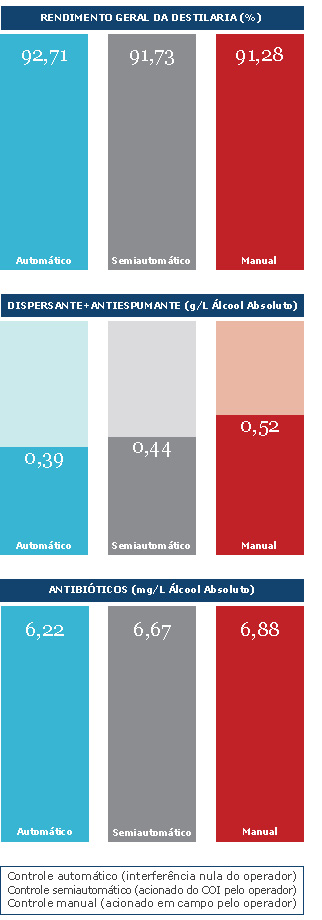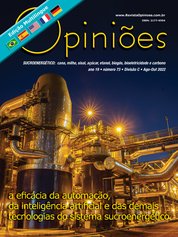Henrique Berbert Amorim Neto e Fernando Henrique C. Giometti
Diretor-presidente e Coordenador de Transferência de Tecnologia da Fermentec, respectivamente
OpAA73
Ganhos reais com automação e integração de sistemas e plataformas
Coautoria: Paulo Roberto Chiarolanza Vilela e Thiago José Barbosa Mesquita, Engº Mecatrônico e Especialista de Aplicação, respectivamente
A integração dessas tecnologias orienta as empresas para as chamadas ”fábricas inteligentes”, em que todos os processos são automatizados e conectados, gerando dados que são armazenados em nuvem e analisados em tempo real por sistemas de inteligência artificial, cooperando com especialistas humanos para decisões rápidas e descentralizadas. Ainda incipientes, algumas dessas inovações já estão em operação ou em pleno desenvolvimento. São exemplos dessa nova realidade:
Automação industrial
Assunto recorrente ainda na Terceira Revolução Industrial, o setor de bioenergia experimentou os avanços da automação industrial, nas três últimas décadas, com a adoção massiva das tecnologias de Controladores Lógicos Programáveis e o surgimento dos centros de operações integradas que controlam desde a chegada da cana até a saída do produto final.
Um bom exemplo desses ganhos reais está na fermentação. Processos fermentativos de alta performance necessitam de atenção especial quanto ao preparo de mosto, condução da alimentação, controle de temperatura e procedimentos de CIP.
A aplicação desse tipo de controle promove uma melhor distribuição do açúcar no tempo, aumentando a eficiência em etanol e reduzindo os custos de produção. Em valores atuais, o aumento do Rendimento Geral da Destilaria (%) do processo manual para o processo automático em 1,43 ponto percentual equivale a mais de R$ 7,4 milhões para uma destilaria que produz 800 m3 etanol/dia.
 Tecnologia Analítica de Processo
Tecnologia Analítica de Processo
O conceito de PAT - Process Analytical Technology, que pode ser traduzido como Tecnologia Analítica de Processo, prevê a transferência das análises de qualidade para as linhas de produção (on-line/inline) e tem forte potencial de aplicabilidade nas indústrias de açúcar e etanol. O principal representante desse conceito é a tecnologia NIR – Near Infrared Spectroscopy.
Praticamente, todas as amostras do setor podem ser analisadas pelo princípio NIR, como cana desfibrada, bagaço, caldos, torta, xarope, massas, méis, mosto, vinho, levedo, açúcar e etanol produzido, possibilitando as detecções analíticas em tempo real e otimizando o processo produtivo.
Aplicações como controle de extração com análise direta de fibra, umidade e açúcares do bagaço na esteira do açúcar produzido e da fermentação já são realidade.
Soluções MES
Dez entre dez gestores sonham em monitorar, em tempo real e com precisão, todas as operações industriais; em que um problema iminente seja detectado e solucionado pela equipe, que tem as informações necessárias para a tomada de decisão antes que ocorram os desvios que comprometam a qualidade ou eficiência da indústria. Isso é possível com as soluções MES (Manufacturing Execution Systems).
Plataformas MES adquirem dados de diferentes fontes (sistemas de gestão, ERP, automação industrial por exemplo), automatizam a organização das informações por equipamento, batelada, operador, turno e realizam análises de métricas e desempenho da produção, controle estatístico de processo, indicadores de capacidade (Cp, CpK), fornecendo uma gama vasta de informações de valor gerencial que reduzem as falhas e aumentam a confiabilidade dos processos.
Fábricas inteligentes
O conceito de fábricas inteligentes consiste em criar um ambiente em que as tecnologias digitais trabalhem em conjunto, conectando sistemas e máquinas automatizadas. Assim, os sensores simples até os analisadores de múltiplos componentes (NIR) geram dados em tempo real, que são armazenados (Big Data) e definem os melhores set-points de forma autônoma, por meio de simulação, otimização e lógica fuzzy. As ações serão acompanhadas por plataformas MES e validadas por modelos preditivos que aprendem continuamente com cada novo dado.
Conclusões
As indústrias de açúcar, etanol e bioenergia têm investido em tecnologias que visam obter informações confiáveis e em tempo real, construindo uma trilha para a Indústria 4.0, elevando a indústria a um patamar inédito de produtividade, qualidade e segurança operacional. A combinação das tecnologias habilitadoras da Indústria 4.0 permite consumir, com facilidade, grande quantidade de dados e gerar análises e avaliações com grande rapidez, algo que, para um humano, poderia levar semanas de trabalho.
Esse método ajuda a revisar e a ajustar as operações com base nas interações e comportamentos recentes da usina, apontando variáveis relevantes, acelerando e automatizando análises complexas, fazendo com que os humanos se concentrem apenas nos aspectos mais relevantes da indústria.
Esse método ajuda a revisar e a ajustar as operações com base nas interações e comportamentos recentes da usina, apontando variáveis relevantes, acelerando e automatizando análises complexas, fazendo com que os humanos se concentrem apenas nos aspectos mais relevantes da indústria.
Isso tudo representa redução de custos e melhor planejamento da produção para as safras atual e futuras para a geração de receitas e prevenção de possíveis prejuízos.




